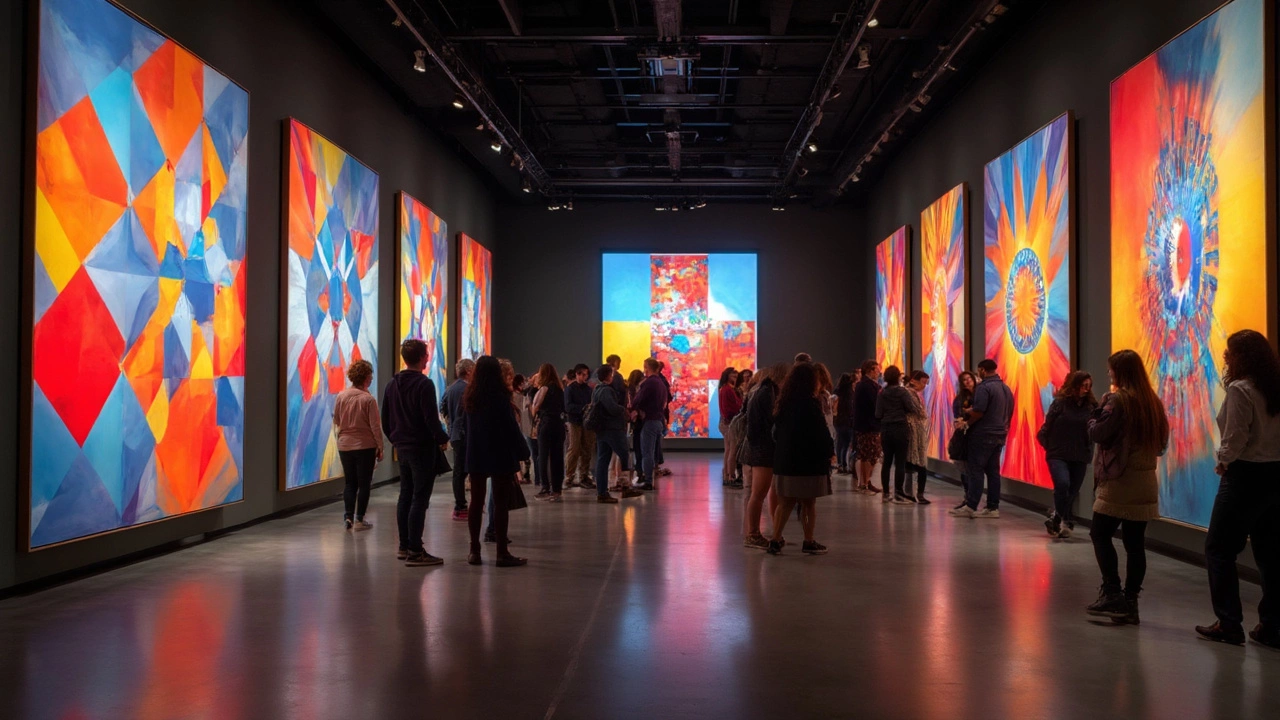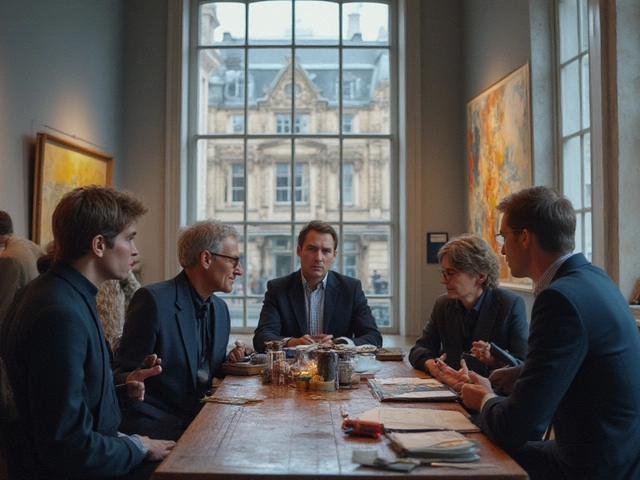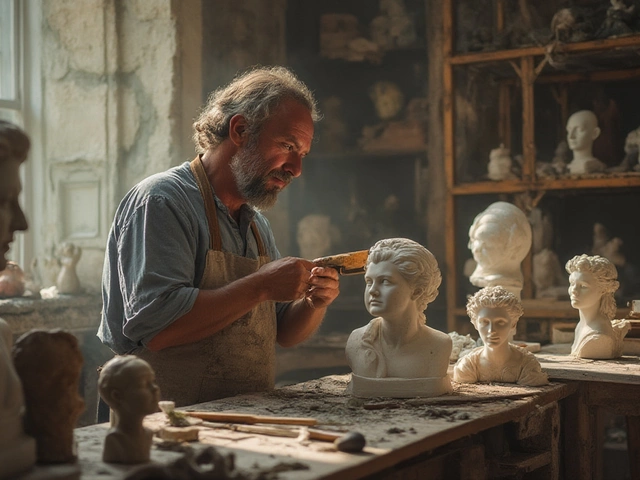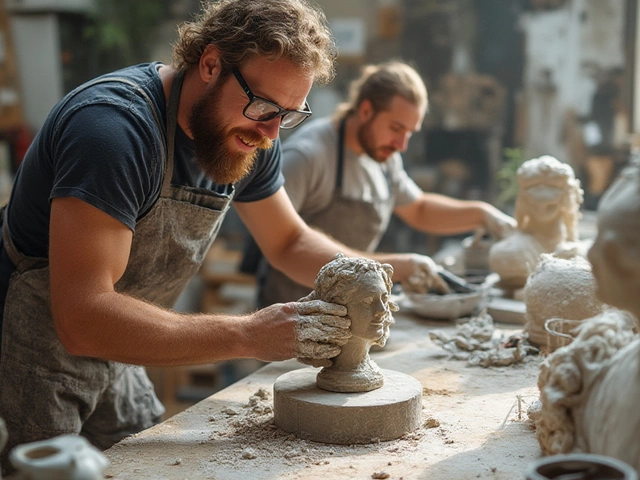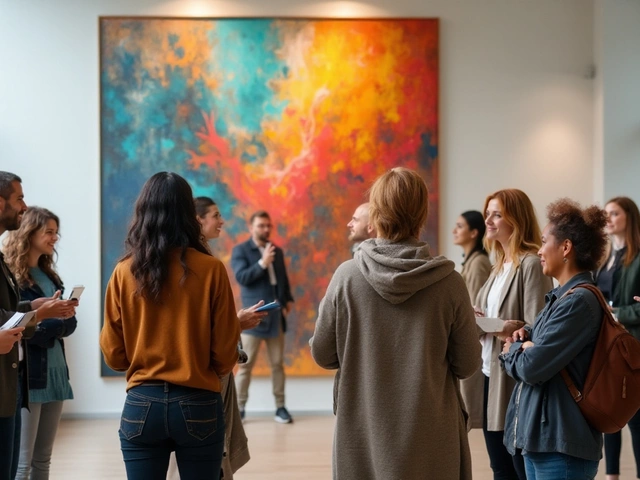Abstract art is where artists ditch the rulebook and let their creativity flow without boundaries. It's not about picture-perfect lines or replicating a scene that everybody can recognize. Quite the opposite, it's about what's happening beneath the surface, capturing emotions, experiences, and concepts in ways that words simply can't.
At a glance, abstract art is mainly divided into three types that each bring something unique to the canvas. First, there's geometric abstract art, which is all about shapes and clear lines. Then, there's abstract expressionism, where artists express their personal emotions with intensity and spontaneity. Lastly, we have action painting, a more energetic take that involves the physical act of painting itself.
So why does abstract art matter? It's impactful because it breaks the norms and lets us explore a reality not confined by rigid structures. It's a conversation starter that can mean different things to different people, sparking curiosity and dialogue. Whether you're an art newbie or a seasoned admirer, understanding these types can enrich your appreciation for this eclectic art form.
- Introduction to Abstract Art
- Geometric Abstract Art
- Abstract Expressionism
- Action Painting
- Impact on Modern Art
- Tips for Appreciating Abstract Art
Introduction to Abstract Art
Abstract art is more than just a bunch of random shapes and colors thrown together on a canvas. It's a bold form of expression that emerged in the early 20th century, setting artists free from traditional representations of reality. This creative movement sparked a shift from detailed, realistic portrayals to a focus on mood, emotion, and the inner workings of the mind.
At its core, abstract art isn’t confined to one definitive meaning. Instead, it invites viewers to explore personal interpretations, becoming an interactive dialogue between the artist and the audience. This was a radical departure from the structured confines of earlier art movements, like the formality of the Renaissance or precision of Neoclassicism.
Origins and Influences
The early abstract artists, such as Wassily Kandinsky and Kazimir Malevich, were pioneers in breaking away from representational art. Kandinsky, often credited with creating the first purely abstract works, believed art should capture the inner essence of the world, not just its outward appearance. Meanwhile, Malevich's 'Black Square' challenged viewers to find beauty and meaning in simplicity. These artists set the stage for new ways of thinking about art that were not only visual but philosophical.
Why Abstract Art?
Why go abstract? For some artists, it's a response to a rapidly changing world. The early 20th century was a time of great upheaval, with two world wars, technological advances, and sociopolitical changes ripping through societies. Abstract art became a way to express the feelings of confusion, loss, and hope that came with these changes. It challenged viewers to look beyond what's tangible, tapping into emotions and concepts too complex for words.
For modern audiences, abstract art continues to resonate. Its lack of clear narrative or subject allows each person to bring their own experiences and ideas into the viewing, resulting in an engagement that's as much about the viewer as the art itself.
Understanding abstract art isn't about "getting it right" — it's about personal connection. Each artwork is an open-ended conversation, inviting you to explore your own thoughts and feelings.
Geometric Abstract Art
When you first encounter geometric abstract art, it might remind you of a complex puzzle or a flashback to math class with its focus on shapes and symmetry. This type of art is all about precision and the clever use of lines and geometry. Artists in this realm play with basic forms like squares, circles, and triangles, taking them to a whole new level.
The roots of geometric abstract art stretch back to the early 20th century, with movements like Constructivism and De Stijl leading the charge. This style marks a departure from traditional artworks that focused on a straightforward depiction of reality. Instead, artists like Kazimir Malevich and Piet Mondrian embraced abstraction to communicate ideas in a pure and simple form.
A Closer Look at the Elements
Geometric abstract art sure has a distinctive look. Colors often appear vibrant and purposeful, contributing to the overall mood of the piece. Lines are clean and intersect at precise angles, creating a rhythm and order that is both calming and thought-provoking. The contrast between shapes and colors leads the eye, engaging the viewer with a visual story.
Even though pieces might appear stringent and calculated, there's a hidden layer of emotion and meaning. These artworks can symbolize balance, harmony, and even a critique of the chaotic world we live in.
Geometric Abstract Art's Modern Influence
This style didn't just fizzle out with those early innovators. It continues to inspire artists today, impacting fields across the board. In fact, the clear lines and structured forms have found their way into modern graphic design and architecture. Think of your favorite sleek skyscraper or the clean, catchy look of a modern logo — that's geometric abstract's influence in action!
| Famous Artist | Notable Work |
|---|---|
| Kazimir Malevich | "Black Square" |
| Piet Mondrian | "Composition II in Red, Blue, and Yellow" |
So, next time you gaze at a piece of geometric abstract art, appreciate the blend of arithmetic precision and artistic freedom. It's more than just shapes and lines. It's an exploration of design and imagination, a playground for the mind bound only by the lines it creates.
Abstract Expressionism
Abstract Expressionism is like the wild child of the art world. It really revved up after World War II, mainly in New York, which helped dub the city as a major art hub. This movement is less about pinpoint precision and more about what's bubbling inside the artist's mind. It's intense, dynamic, and lets artists express their feelings straight onto the canvas.
Names like Jackson Pollock and Mark Rothko might ring a bell. Pollock's famous for his drip paintings, where he let paint fall onto canvas in seemingly random patterns, creating a kind of chaos that actually looks pretty amazing. On the flip side, Rothko played with vast fields of color to evoke emotions. It's not just about what you see but also what you feel when you're soaking in these paintings.
Characteristics of Abstract Expressionism
There are a few hallmarks to look for inAbstract Expressionism. One biggie is spontaneity. These artists didn't plan out where every single brush stroke would go. They just went with it, letting the art evolve in the moment. It's about the rawness and the rush of painting.
- Action Painting: This approach was all about the physical act of painting. Imagine an artist energetically dancing across the canvas, using their whole body to paint. Pollock was a master here.
- Color Field Painting: Here, you're looking at broad swaths of color, meant to envelop you in a sea of emotion. Rothko's work is a prime example.
- Emotional Intensity: Whether through a chaotic mesh of lines or a silent storm of color, the work aims to connect with you on an emotional level.
Wondering why it's so impactful? Abstract Expressionism came at a time when the world was pretty shook up by the war. It offered artists a fresh way to engage with and express their psyche in a world starved for new takes.
| Artist | Signature Style |
|---|---|
| Jackson Pollock | Drip Paintings |
| Mark Rothko | Color Fields |
With Abstract Expressionism, the canvas became more than just a surface for painting—it became an extension of the artist's inner world. This style invites the viewer to step in and interpret the whirlwind of emotion and creativity themselves. It's not just art—it's a personal journey every time you look at a piece.
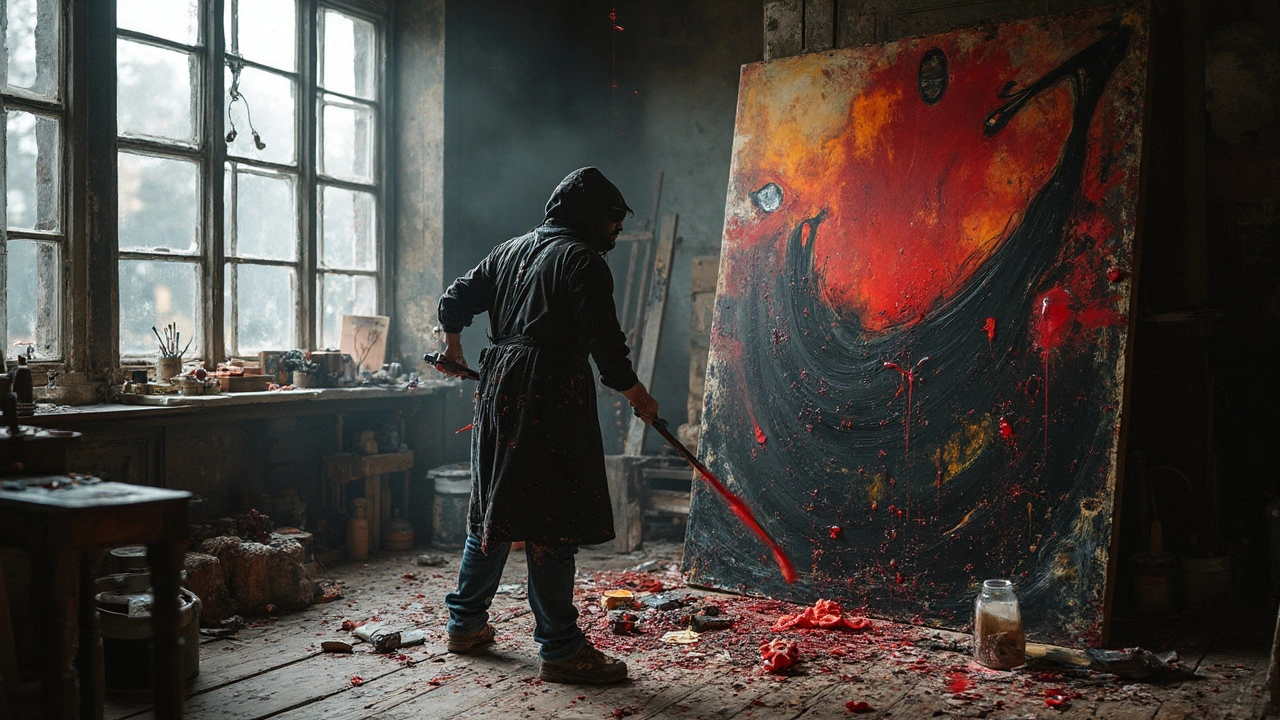
Action Painting
Action painting is like the adrenaline rush of the abstract art world. Forget about carefully planned brush strokes—here, it's all about who can capture their vibes on canvas in the wildest way possible. This form of art became big in the 1940s and 1950s, mostly thanks to legends like Jackson Pollock. You might have heard about him; his claim to fame was literally dancing around a canvas while flinging paint around.
Imagine standing in front of an enormous canvas. Instead of gingerly placing a brush, artists like Pollock would let loose, pouring and splattering paint from all angles. This approach was about making the act of painting a performance, where the energy of movement was captured directly on the canvas itself.
Why Action Painting Stands Out
Here's why action painting makes its mark: it's a total engagement of the body and the mind. Unlike more controlled styles, the unpredictability of action painting leaves room for experimentation and spontaneity. This method reflects a dynamic process where the end result is as important as the journey to get there. The canvas tells a story of movement, motion, and raw expression.
Key Figures and Their Contributions
- Jackson Pollock: Known for his "drip technique," Pollock's work put action painting on the map. He described his process as being "in" the painting, creating epic swirls and loops.
- Willem de Kooning: A contemporary of Pollock, he combined abstract gestures with recognizable figures, helping broaden the style.
- Franz Kline: Famous for his bold black-and-white compositions, he contributed a simple yet striking twist to action painting.
Action painting challenges not just the norms of art styles but also how people connect to art. It’s engaging, full of surprises, and definitely a conversation starter. So, next time you see a piece that looks like a wild splash of paint, remember it's more than just mess—it's a window into the artist's moment, captured forever in color.
Impact on Modern Art
When we think of abstract art, it's easy to imagine something radical, and that's exactly the point. Abstract art has broken barriers and redefined how we approach art. It tossed the classical rulebook out the window and paved the way for a more open-ended view of creativity.
Why does this matter in modern art? For starters, it inspired artists to delve into personal expression without fear of judgment. Early 20th-century movements like Cubism and Futurism were heavily influenced by abstract principles, encouraging not just experimentation but also critical thinking in art production.
Moreover, the cultural ripple effect of abstract art is vast. It infiltrated different fields such as design and architecture, where the focus shifted towards minimalism and functionality. Modern artists started to explore form, color, and texture in everyday objects, making art not confined to galleries but present in our daily lives.
The Democratization of Art
Abstract art also played a big role in democratizing the art world. Without precise guidelines, art became something everyone could experience and interpret in their own way. This shifted the power dynamics, allowing art to become more accessible to diverse audiences. It instigated dialogue and curiosity, no longer bounded by the elite few but open for global discussion.
Abstract art's freedom extends beyond individual impact. It has laid a foundation for contemporary art movements and continues to be a source of inspiration, shaping how modern societies view creativity and innovation. Bottom line? It's not just an art form; it's a catalyst for change across the creative landscape.
Tips for Appreciating Abstract Art
Abstract art might look intimidating if you're used to the more traditional stuff, but it doesn't have to be. Here's how you can start appreciating it like a pro.
Let Go of Expectations
First off, drop any expectations of what art ‘should’ look like. The beauty of abstract art lies in its unpredictability. Instead of hunting for recognizable forms, give yourself a moment to just take in the shapes, colors, and textures.
Focus on Emotion and Experience
Ever find yourself resonating with an abstract painting even if you don’t understand it? That’s because abstract art often focuses on emotion over logic. Ask yourself, “How does this piece make me feel?” Those emotions are your clues toward understanding what the painting is all about.
Take Your Time
Abstract paintings often have layers of meaning. Spend time by observing the different elements in the composition. This isn’t the Louvre, and there's no rush. Linger around and see what captures your eye as you get lost in thought.
Seek Context
It can definitely help! Read about the artist or the circumstances under which the work was created. Sometimes, a little backstory can add depth to your appreciation.
Visit Galleries
Online images don’t always do abstract art justice. If you can, visit galleries to experience the works in person. Seeing the actual scale and vibrancy of the colors makes a huge difference.
Discuss with Others
Talk with friends or other art lovers. Sharing perspectives can open your eyes to aspects you might have overlooked and adds richness to the experience.
| Abstract Art Event | Location | Date |
|---|---|---|
| Contemporary Art Show | New York, USA | June 2025 |
| Vancouver Abstract Week | Vancouver, Canada | August 2025 |
Remember, there's no wrong way to enjoy art. Whether you're deeply touched or just curious, each reaction is valid. Dive into the diversity and let abstract art speak to you.
